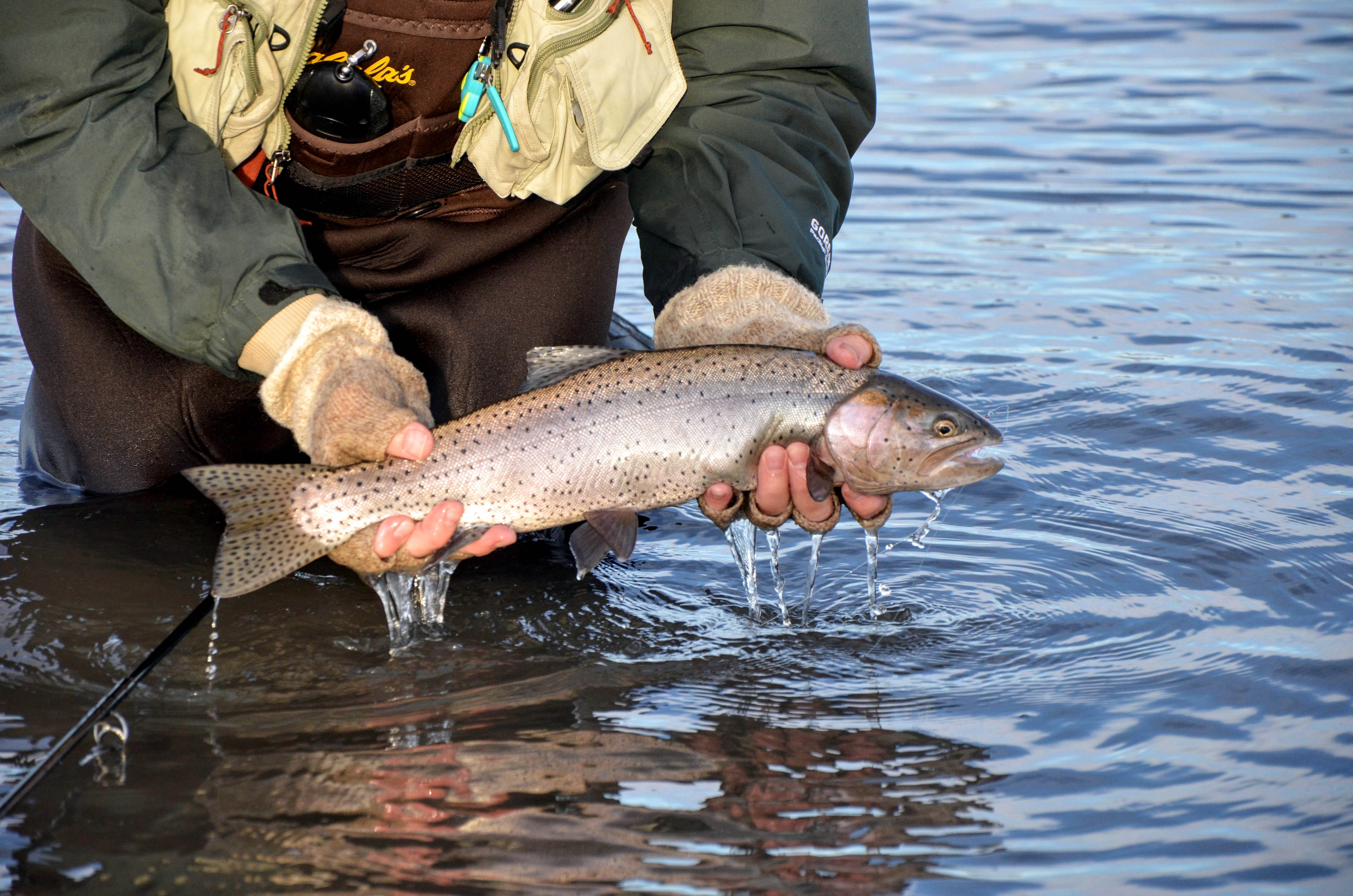Imagine it being January at one of the most desolate lakes in America—Pyramid Lake. You’re standing on your ladder in the water, bundled up in what never seems like enough layers, and donning ever-so-flattering neoprene waders. Just as you wonder why you brave the stinging cold and miserable wind, you feel it and set. It feels like a car engine is on your hook, and your line screeches as the fish takes you into your backing almost before you can blink. The fish porpoises through the water’s surface and shows you its massive back. This 15-pound Lahontan Cutthroat reminds you why you’re out here.

This is a scene not uncommon at Pyramid Lake in Nevada, often referred to as “Pyramid” or “The Mid.” The fishery is home to Sacramento perch, Cui-ui, Tui chub, Tahoe suckers, and two strains of Lahontan cutthroat—the Summit and the prized Pilot Peak. Pyramid has been likened to the famed Strobel Lake in Argentina for its massive fish and its eerie surrounding moonscape. The record size trout for Pyramid is 41 pounds caught in 1925, and while modern fishers have yet to break the 30-pound mark, double-digit fish are caught each week.
It’s definitely a bucket-list destination, and if you’re thinking of going, here are some of the basics that will get you started.

WHEN TO GO
The fishing season for trout starts October 1st and ends June 30th, but you can fish for the other species year around. Many of the largest trout are caught during the late fall and winter months. You won’t get numbers, but what you get is oftentimes BIG. Springtime (March and April) also provides a chance at a “Big” (anything 10 pounds or over) and more fish will bite right before the spawn (around May).

Just of few of the flies
BASIC FLIES
Although every angler seems to have a treasured “magic” fly, most are based off of one of six patterns: wooly buggers (sizes 6-8), balanced leeches (sizes 6-10), beetles (sizes 8-10), boobies (sizes 8-10), tadpoles (sizes 8-10), and midges (sizes 8-12) that mimic Chironimid or Calibaetis insects. Some of the most common names you’ll hear are Midnight Cowboy, Martini Olive, and Albino Wino. The colors most favored by fishers are black, purple, white, chartreuse, olive, pink, and maroon. In moments of quiet desperation, some use spinning rods and chuck out spoons of various sizes and colors as far as they can throw them.
WHAT GEAR TO BRING
In addition to bringing your biggest net, bring your best lake rod, which is preferably an 8 wt. or heavier—most fishers use a 10-ft., 8-wt.—and your shooting-head sinking line. The shooting head is for stripping leeches, beetles, tadpoles, and boobies. Bring a floating line for indicator fishing with nymphs.

Also, the weather can be miserable. So, dress warmly and wear your warmest neoprene waders if you’re fishing during the fall or winter.

Finally, unless you’re fishing from a boat or float tube, bring a ladder. This is because when the fish come in toward shore, they hang around the shelves. Unfortunately, the shelves are often far out, so you want to walk as far as you can out into the lake, stick your ladder into the lake bottom, and step up on the ladder to gain leverage for casting and to get your legs out of the cold water. A metal ladder from the local hardware store will do, although there are fancier versions out there with padded seats if you like.

CHASE THE WIND
One of the rules of Pyramid is that the more miserable the weather is, the better the fishing. Blue-bird skies are rarely favorable. Instead, look for overcast days and days when the wind is blowing right in your face. This is because the wind pushes bait fish in to shore and the trout follow them, which gives ladder anglers a good chance of fish seeing their flies.
If the wind picks up and you’re having trouble throwing your line out, then try a sidearm cast. Or, you can cast backwards and then turn around to face your flies after casting. Yes, I’m serious.

However, be wary of the wind if you’re floating in a pontoon, float tube, or kayak. The wind can change in an instant and people have disappeared because of it—although some blame the infamous “water babies” (think angry and murderous baby spirits) more than the wind. Make sure to have an anchor, a buddy, and preferably a walkie-talkie with your buddy.

THE RULES
You do not need a Nevada fishing license, but you do need a license from the Pyramid Lake Paiute Indian Reservation tribe since Pyramid is on Native land. You can get a license online or at most sporting goods stores in town. Additionally, you cannot use bait and you need to clip all your barbs. I know. This one hurts considering how big of a fish might get away. Nevertheless, the game wardens will ticket you if they see a barb.
The sizes of the fish that you can keep are 17-20 inches or over 24 inches, and you can keep two of the smaller ones or one small one and one over 24 inches. Know that people don’t look kindly on keeping big fish though. I’ve heard that the big ones are mushy tasting anyway.
Lastly, you cannot leave your ladder unattended for extended periods of time. If you go to your car to warm up, that’s fine. But you cannot leave your ladder in the lake overnight to save your place.

AFTERCARE
Pyramid’s waters are fairly alkaline and slightly salty, which is hard on gear. So, rinse all of your rods, reels, waders, and ladders to save them from corrosion.

CHIN UP
It’s not uncommon to get only one or two bites during several hours of fishing or to get totally skunked. Keep casting because you never know when the mysterious Pyramid will leave you humbled or reward you with the fish of a lifetime.

